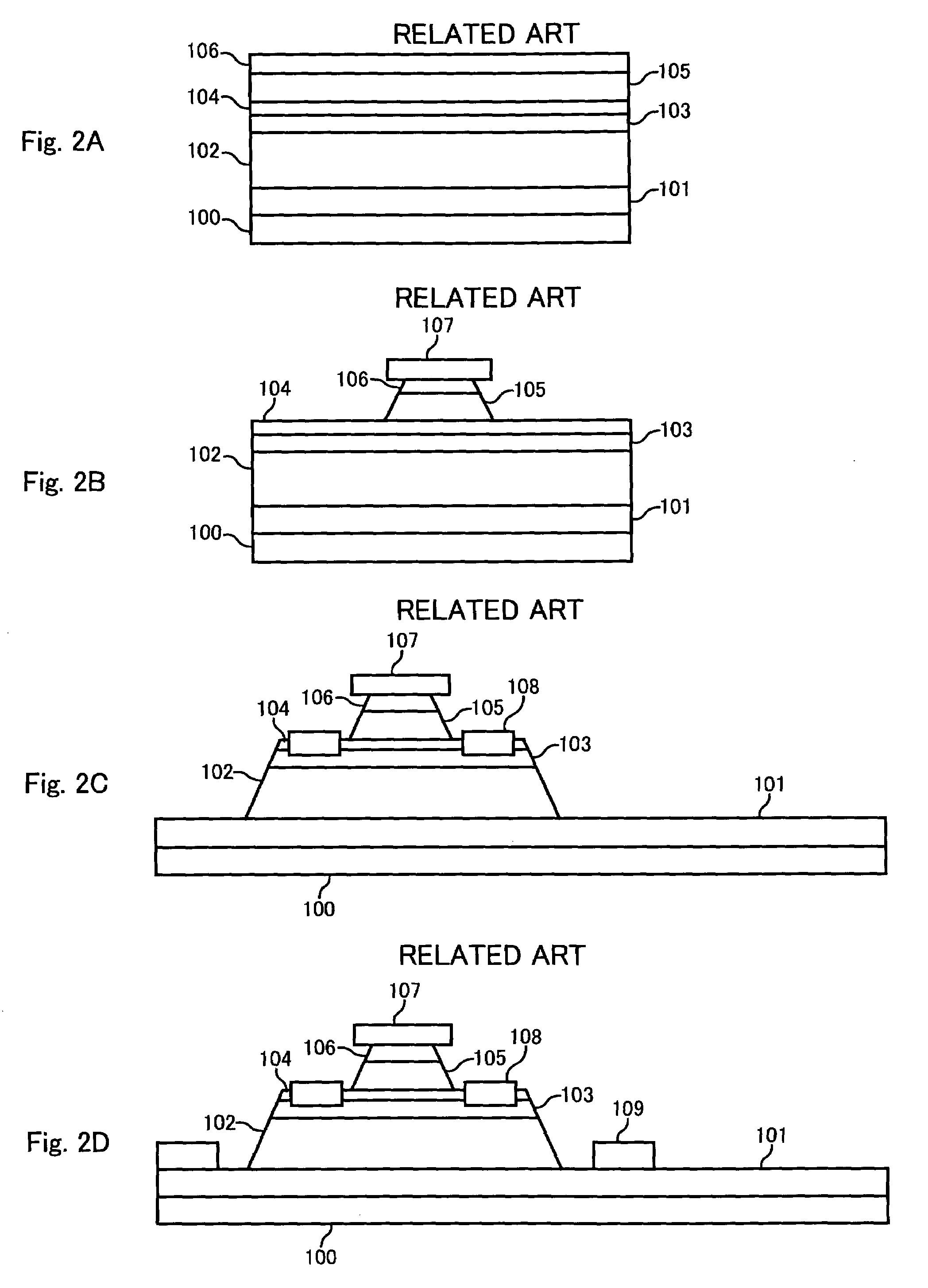Semiconductor device and method of manufacturing the same
a technology of semiconductors and semiconductors, applied in semiconductor devices, electrical devices, transistors, etc., can solve the problems of reducing reliability, reducing current gain, and difficult to completely insulate the sub-collector layer, so as to reduce the resistance of the collector and achieve easy planarization. , the effect of expanding the range of materials
- Summary
- Abstract
- Description
- Claims
- Application Information
AI Technical Summary
Benefits of technology
Problems solved by technology
Method used
Image
Examples
first embodiment
[0033]A first embodiment of the present invention is explained hereinafter with reference to FIG. 3.
[0034]FIG. 3 is an explanatory view showing an example of the cross section of one device element of the semiconductor device according to the present invention. On a semi-insulating GaAs substrate 100, a first sub-collector layer 101a, an etching stop layer 101c, a second sub-collector layer 101b, a collector layer 102, a base layer 103, an emitter layer 104, an emitter cap layer 105, and an emitter cap layer 106, each having a given shape, are sequentially laminated.
[0035]Unlike the conventional one, the sub-collector layer of this embodiment consists of three laminated layers: the first sub-collector layer 101a at the bottom, the etching stop layer 101c, and the second sub-collector layer 101b at the top. The first sub-collector layer 101a has an element insulating region 110 made by ion implantation. The second sub-collector layer 101b has a recess-shaped element insulating region...
second embodiment
[0047]A second embodiment of the present invention is explained hereinafter with reference to FIG. 5.
[0048]FIG. 5 is an explanatory view showing an example of the cross section of a semiconductor device different from the above-described device. The same elements as in FIG. 3 are denoted by the same reference symbols and redundant description is omitted.
[0049]In this embodiment, the second sub-collector layer 101b only is selectively etched away using the etching stop layer 101c as a stopper, thereby creating the recess-shaped element insulating region 111. The etching stop layer 101c is not etched away. Then, ion implantation with boron and so on is performed both on the exposed etching stop layer 101c and the first sub-collector layer 101a, thereby creating the element insulating region 110 to insulate adjacent device elements from each other.
[0050]This configuration offers substantially the same effect as the above embodiment.
third embodiment
[0051]A third embodiment of the present invention is explained hereinafter with reference to FIG. 6.
[0052]FIG. 6 is an explanatory view showing an example of the cross section of a semiconductor device different from the above-described devices. The same elements as in FIG. 3 are denoted by the same reference symbols and redundant description is omitted.
[0053]This embodiment is different from the above embodiment in that it eliminates the etching stop layer.
[0054]Thus, the first sub-collector layer 101a is made of the material which has etching selectivity against the second sub-collector layer 101b.
[0055]For example, the first sub-collector layer 101a is formed of GaAs, and the second sub-collector layer 101b is formed of AlGaAs, InGaP, or InGaAsP. For another example, the first sub-collector layer 101a is formed of AlGaAs, and the second sub-collector layer 101b is formed of InGaP or InGaAsP. For still another example, the first sub-collector layer 101a is formed of InGaAs, and t...
PUM
 Login to View More
Login to View More Abstract
Description
Claims
Application Information
 Login to View More
Login to View More - R&D
- Intellectual Property
- Life Sciences
- Materials
- Tech Scout
- Unparalleled Data Quality
- Higher Quality Content
- 60% Fewer Hallucinations
Browse by: Latest US Patents, China's latest patents, Technical Efficacy Thesaurus, Application Domain, Technology Topic, Popular Technical Reports.
© 2025 PatSnap. All rights reserved.Legal|Privacy policy|Modern Slavery Act Transparency Statement|Sitemap|About US| Contact US: help@patsnap.com



